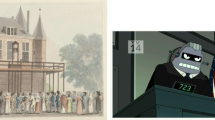Abstract
The paper identifies and assesses the implications of two approaches to the field of artificial intelligence and legal reasoning. The first — pragmatism — concentrates on the development of working systems to the exclusion of theoretical problems. The second — purism — focuses on the nature of the law and of intelligence with no regard for the delivery of commercially viable systems. Past work in AI and law is classified in terms of this division. By reference to The Latent Damage System, an operational system, the paper articulates and responds to conceivable purist (jurisprudential and AI) objections to such a program. The methods of the pragmatist are also called into question and refined. The author concludes that pragmatism within a purist framework is the only sound approach to developing reliable AI systems in law.
Similar content being viewed by others
References and Notes
McCarty, L. Thorne. (1977). Reflections on TAXMAN: An Experiment in Artificial Intelligence and Legal Reasoning.Harvard Law Review. 90. 837.
Sergot, M., Sadri, F., Kowlaski, R., Kriwaczek, F., Hammond, P. and H. Cory. (1986). The British Nationality Act as a Logic Program.Communications of the ACM. 29. 370.
For a review of the system in question, see Susskind, R.E. (1987). Expert Systems in Law and the Data Protection Adviser.Oxford Journal of Legal Studies. 7. 145.
Some of Phillip Leith's early work is described inELI: An Expert Legislative Consultant (Conference Publication No. 212, presented at IEE Conference on Man/Machine Systems, UMIST, 6–9 July, 1982). An example of his later work is The Application of AI to Law, (1988).AI & Society. 2. 31.
Gardner, A.v.d.L. (1987).An Artificial Intelligence Approach to Legal Reasoning. MIT Press, Cambridge, Mass.
Waterman, D., Paul, J. and M. Peterson. (1986). Expert Systems for Legal Decision Making.Expert Systems. s.212.
Bing, J. (ed.) (1987).F⋆KUS: Knowledge Based Systems for Public Administration. Norwegian University Press, Oslo.
Smith, J.C. and C. Deedman. (1987). The Application of Expert Systems Technology to Case-Based Law, inProceedings of The First International Conference on Artificial Intelligence and Law. ACM Press, New York.
Greenleaf, G., Mowbray, A. and A.L. Tyree. (1987). Expert Systems in Law: The DataLex Project, inProceedings of The First International Conference on Artificial Intelligence and Law. ACM Press, New York.
For a full exposition of this area of law, see Capper, P.N. (1987).The Latent Damage Act 1986: The Impact on the Professions and the Construction Industry. Legal Studies and Services Ltd., London.
See Gold, D.I. and R.E. Susskind. (1985). Expert Systems in Law: A Jurisprudential and Formal Specification Approach, in Martino and Natali (eds.)Atti Preliminari Del II Convegno Internazionale di studi su Logica, Informatica, Diritto. Consiglio Nazionale delle Ricerche Istituto per la documentazione giuridica, IBI.
Susskind, R.E. (1987).Expert Systems in Law. Oxford University Press, Oxford.
Ibid.
Ibid. pp. 237–245.
Dworkin, R.M.Law's Empire. (1986). Collins Fontana, Glasgow. 17.
See Susskind, R.E. (1987).Expert Systems in Law. Oxford University Press, Oxford.
Capper, P.N. and Susskind, R.E. (1988).Latent Damage Law — The Expert System. Butterworth, London.
Susskind, R.E. (1988). Government Applications of Expert Systems in Law. In Duffin (ed.)IKBS in Government. Ellis Horwood, Chichester.
See Gardner, A.v.d.L. (1987).An Artificial Intelligence Approach to Legal Reasoning. MIT Press, Cambridge, Mass.
For further details on the commercial exploitation of expert systems in law, see Susskind, R.E. (1987). Expert Systems in Law: Out of the Research Laboratory and into the Marketplace. InProceedings of 1st International Conference on Artificial Intelligence and Law. ACM Press, New York.
Author information
Authors and Affiliations
Rights and permissions
About this article
Cite this article
Susskind, R. Pragmatism and purism in artificial intelligence and legal reasoning. AI & Soc 3, 28–38 (1989). https://doi.org/10.1007/BF01892673
Issue Date:
DOI: https://doi.org/10.1007/BF01892673




